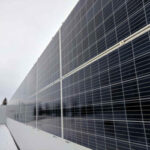Introduction to Industrial Solar PV
Photovoltaic (PV) technology, a significant form of solar energy conversion, harnesses sunlight to generate electricity. At the core of this process are solar cells, which convert light energy into electrical energy through the photovoltaic effect. When light photons strike a solar cell, they energize electrons, creating a flow of electricity. This technology has witnessed substantial advancements in efficiency and cost-effectiveness, making it increasingly viable for various applications, particularly in industrial settings.
The integration of solar PV systems in industrial applications is transforming energy consumption in factories, warehouses, and production facilities. Companies are discovering that solar energy can significantly reduce operational costs by minimizing reliance on traditional energy sources. Moreover, as energy prices continue to rise, solar PV offers financial predictability through fixed-cost energy procurement. Such solar installations can lead to substantial savings on energy bills over time, especially for energy-intensive industries.
Beyond economic advantages, the adoption of solar energy in industrial sectors contributes to a reduction in carbon footprints, thereby promoting sustainability. Industries are under increasing pressure to implement environmentally friendly practices, and transitioning to renewable energy sources like solar PV aligns with global sustainability initiatives. This shift not only fosters a positive corporate image but can also enhance compliance with regulatory demands regarding emissions and energy usage.
Furthermore, as technological advances continue, the performance and scalability of solar PV systems are improving, encouraging more extensive adoption among industrial players. This trend reflects a growing acknowledgment of the importance of sustainability and resilience in energy strategies. As industries increasingly prioritize renewable energy solutions, the potential for scaling up solar PV technology becomes evident, paving the way for a more sustainable future in industrial energy consumption.
Advantages of Scaling Up Solar PV in Industries
The integration of large-scale solar photovoltaic (PV) installations within industrial operations presents numerous advantages that are increasingly being acknowledged across various sectors. One of the most significant benefits is the substantial reduction in energy costs. By harnessing solar energy, industries can lower their dependence on fossil fuels, thereby mitigating fluctuations in energy prices. This financial savings can redirect funds towards other critical areas, such as research and development, ultimately enhancing business growth.
Moreover, scaling up solar PV systems provides industries with an opportunity for improved energy independence. As manufacturing processes often require a considerable amount of energy, establishing a robust solar power system allows companies to generate their own electricity. This shift not only minimizes vulnerability to grid disruptions but also safeguards against future energy price volatility. As a result, industries can achieve a more stable energy supply that supports continuous operations.
In addition to economic advantages, the adoption of large-scale solar PV significantly enhances corporate sustainability efforts. As concerns regarding climate change intensify, consumers and stakeholders increasingly favor companies that demonstrate a commitment to environmentally friendly practices. By transitioning to solar power, industries can drastically reduce their carbon footprint, showing a proactive stance towards sustainability. This transition aligns with global efforts to promote renewable energy and decrease greenhouse gas emissions.
The public perception of a company is also positively influenced by the adoption of large-scale renewable energy solutions. Consumers are more inclined to support businesses that prioritize sustainability, leading to enhanced brand loyalty and potentially higher sales. Case studies reveal that companies investing in solar technology not only improve their operational efficiency but also gain recognition as industry leaders in sustainability. Therefore, scaling up solar PV installations allows industries to reap multifaceted benefits, which ultimately foster a more resilient and future-oriented business model.
Challenges in Scaling Up Solar PV for Industrial Applications
The transition to solar photovoltaic (PV) systems in industrial settings involves several significant challenges that can hinder effective implementation and scaling. One of the primary barriers is the financial commitment required to invest in solar technologies. High initial installation costs can deter companies from adopting solar energy solutions, particularly smaller enterprises that may lack sufficient capital. Additionally, the return on investment (ROI) may not be immediately apparent, which can create hesitation among stakeholders who are focused on short-term financial performance.
Alongside financial barriers, regulatory hurdles present substantial obstacles for industries aiming to implement solar PV solutions. Navigating varying local, state, and federal regulations can complicate the deployment of solar technologies. This includes obtaining necessary permits, adhering to building codes, and complying with interconnection standards set by utility companies. Such complexities often lead to delays in project execution and can escalate costs, further discouraging industries from scaling up their solar initiatives.
Spatial constraints within industrial facilities also pose a significant challenge. Many manufacturing sites often have limited roof space or are situated in locations where the physical environment does not permit adequate solar installation. This is particularly true for densely populated regions or urban settings where real estate is at a premium. Addressing these space limitations necessitates innovative solutions, such as adopting solar canopies or integrating solar PV systems into existing infrastructure.
Finally, technical issues related to the integration of solar PV systems with existing energy infrastructures present additional challenges. Companies frequently encounter compatibility issues with their current energy management systems which can complicate solar integration. To tackle these challenges, industries can explore various solutions like securing financing through innovative models, engaging in public-private partnerships, and leveraging advancements in technology that facilitate solar deployment. These strategies not only help to overcome barriers but also enhance the feasibility and attractiveness of solar PV applications in the industrial sector.
Future Trends and Innovations in Solar PV for Industries
The landscape of solar photovoltaic (PV) technology is evolving rapidly, driven by a range of emerging trends and innovations that promise to redefine its application within industrial settings. Key among these advancements are energy storage solutions and smart grid technologies. Energy storage, which encompasses batteries and other systems, allows industries to store excess solar energy generated during peak sunlight hours. This capability ensures a continuous energy supply, mitigating the intermittent nature of solar power and enhancing operational efficiency.
Furthermore, the integration of smart grids is becoming increasingly beneficial for industrial applications of solar PV. Smart grids utilize advanced communication technology to manage energy distribution more efficiently, allowing industrial facilities to respond dynamically to changes in energy demand and supply. This not only helps in optimizing energy consumption but also enhances the economic viability of solar PV systems by maximizing their integration into existing power infrastructure.
Technical advancements in solar panel efficiency are further propelling industrial applications. Innovations such as bifacial solar panels, which can absorb sunlight from both sides, and multi-junction cells, which combine two or more semiconductor materials to capture a broader spectrum of sunlight, are significantly increasing energy output. As efficiency improves, the cost per watt of solar energy decreases, making it more accessible for various industries.
As organizations strive toward achieving net-zero emissions targets, the role of solar PV is more crucial than ever. With the growing emphasis on sustainability, industries are likely to increase their investments in renewable energy sources, including solar. The future landscape will witness a broader adoption of solar technologies, making them integral to the efforts in curbing greenhouse gas emissions and promoting a transition toward greener industrial practices. Innovations in energy storage and grid management will support this shift, paving the way for a sustainable energy future in the industrial sector.









